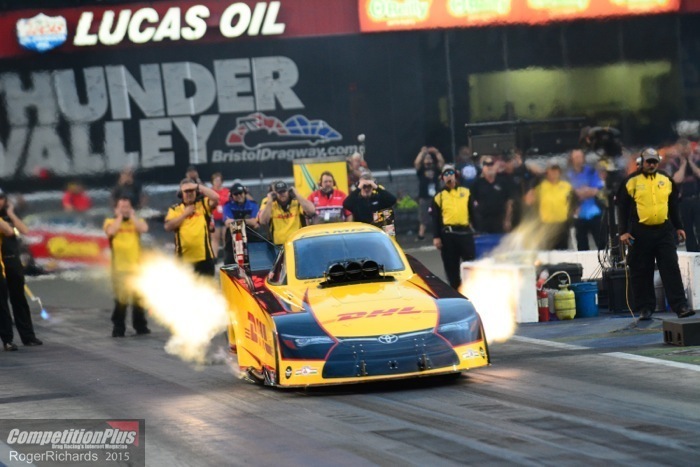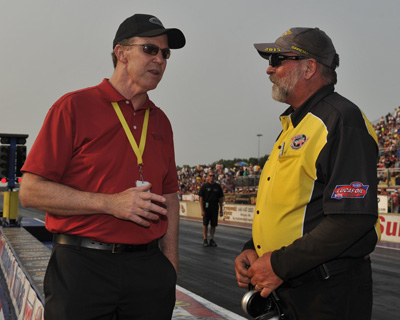CLIFFORD’S SIX-STEP INITIATIVE PLAN TO GROWING NHRA

 Peter Clifford had a plan in his mind for 18 years.
Peter Clifford had a plan in his mind for 18 years.
For 18 years, the new NHRA President, who served as the Executive Vice President and General Manager for the Glendora, Ca.-based sanctioning body, jotted down ideas and kept a journal of changes he'd love to implement if he were ever in the driver's seat.
On July 12, 2015, Clifford was handed the keys to the original extreme sport. Within two days, he implemented the first initiative, of a six-step process with the intention of reinvigorating the NHRA.
Two weeks later, because of a need for longer preparation, Clifford introduced Initiative No. 5, by announcing wholesale changes to the Pro Stock division to take effect in the 2016 season.
Initiative No. 5 is a plan for better competition.
And just like a complex puzzle, Clifford has added piece by piece to the major organization to make big league championship drag racing relevant to not only its core audience, but to create appeal for those who simply see drag as the long cars with parachutes.
His vision of grandeur for the sport had to start with the benchmark of any successful motorsports entity – television.
"Simple as that, when you are tape delayed, you cannot engage the fans," Clifford said with a serious look on his face. "When you are a major league sport, you have live coverage. If we wanted to be taken serious in the corporate world, we needed live coverage to make our mark."
Of the 24 events the 2016 season, 17 will be aired live. If Clifford had his druthers, all 24 would air in real time. However, the new NHRA television partner, Fox Sports, suggested the NHRA not go head-to-head with NASCAR, and this is instruction he's more than willing to follow.
Clifford understands now with Fox comes a broadcast partner who engages in ensuring drag racing gets the best bang for its buck.

"For the first time in drag racing history, our sport will be live on a major network," Clifford pointed out, pointing at live races on schedule to broadcast on the Fox main network. Those races will include Denver, Seattle, Sonoma and Indianapolis.
"This is the game changer for us," Clifford said. "We have access to a totally new television audience. It is much bigger than anything we have ever had before. This comes at the right time in the season when our team has had the opportunity to gel in working together."
This season's television package will offer a bump from 120 hours of annual programming to upwards of 500 hours, including Friday night qualifying.
Clifford said the in-house production program was not a matter of wanting to micro-manage but a simple belief no one understands how to tell NHRA's story better than NHRA itself. According to Clifford the addition of award-winning television executive Ken Adelson is just another way of the NHRA putting their money where their mouth is.
The NHRA he said will soon become a content factory determined to tell its story like no one else.
As another value adder to what Clifford believes is the most robust television package ever, will be a graphics package aimed at making the sport easier to watch and understand for both the seasoned, and novice viewers.
The NHRA has retained the services of Sport Vision, a Northern California-based television graphics provider, to create new entities such as a finish line marker created in the image of the first down marker, the company created for football broadcasts.
"The finish line will be easily identified, as well as both lanes will be easily identified," said Clifford. "It will make it easier to explain because it has been confusing for a while.
"The graphics is so cool that it sets us apart. The animated logo is quite impressive and has mainstream sport written over it."
Initiative No. 2 was introduced at the end of 2015, relaxing some of the procedures related to sportsman licensing and participation.
"We look at this sport as a pyramid with the Mello Yello Drag Racing Series competition at the top, and the sportsman racing is the base," said Clifford. “We need to continue to grow the base. A pyramid cannot grow unless the base does. It's important that we reiterate in our words and actions how important the sportsman racer is to us."
Clifford said there is a concerted effort underway to weld Initiative No. 1 and No. 2 together, with the goal of having the sportsman show as appealing as the professional presentation.
The third initiative Clifford has worked to implement is expanding the marketing partnerships across the board from the series to the participant. To accommodate this, Clifford said he has doubled in size the sales force, both internal and external.
 "This is not only to help us gain more sponsorship but also the teams and tracks as well," Clifford explained. "We are meeting with race teams on a regular basis, and race tracks on how we can work better together."
"This is not only to help us gain more sponsorship but also the teams and tracks as well," Clifford explained. "We are meeting with race teams on a regular basis, and race tracks on how we can work better together."
Clifford's fourth initiative is aimed at expanding the NHRA's media fingerprint in the motorsports world. With the introduction of Terry Blount to head up the media approach, the goal is to get drag racing more mainstream.
Case in point, at the recent NASCAR Media Tour in Charlotte, NC., Clifford, Blount and NHRA racers John Force and Antron Brown were in attendance giving a special presentation in a full zMax Dragway media center on the benefits of the new Fox Sports television package.
Clifford believes the increased media presence will enable the sanctioning body a better opportunity to not only grow the sport but to get more input on how his team can make it better.
"We have started a fan council which will rotate members on and off, and the goal is to get truly objective feedback," said Clifford. "We count on them to tell us what we are doing right and wrong."
One aspect Clifford knew was essential was in creating better competition for not only those racers on the track but those in the grandstands who paid to watch drag racing, not clean-up crews making laps up and down the strip.
"The teams are in agreement with us, we need to find a solution for these oildowns," said Clifford. "If we can cut out the oildowns or greatly reduce them, that's crucial, and can change this sport overnight. It not only impacts those sitting in the stands but could impact our live television broadcasts. The oildowns have to stop from sportsman to professional racers."
Adding to his point, Clifford said he has commissioned his technical department to begin working with the teams, and already sees progress in a short time.
"The crew chiefs have come up with a lot of ideas on their own," Clifford added.
One of those ideas, Clifford said, includes an oil pan pressure switch aimed at shutting down the engine at abnormally high readings.
"They don't want the engine to explode, nor do we," Clifford explained. "If we can reduce those chances of an explosion, it naturally reduces the chances for oil on the track."
Other changes pondered include high rpm shut off devices, and improvement of the containment device design. He didn't rule out the potential for additional tech inspections in the lanes so as to prevent the incidents which put oil on the racing surface.
Clifford said the NHRA has already invested in new machines to speed up the track cleaning process. Additionally, the Safety Safari plans to use hot water in removing the oil from the racing surface. To do this, the power scrubbers will now be equipped with heaters to warm the water before application. The NHRA has even requested and received assistance in this project from Purdue University.
"We are going to do everything in our power to speed up the process, and on the same token, the teams are working to ensure it doesn't happen in the first place."

The retooling of the Pro Stock cars was another area Clifford believed was essential to rekindle fan interest as well as manufacturer participation.
"I absolutely love the way the cars look now," Clifford said. "I think they look awesome. Our goal is to make these cars more relevant to the fans and Detroit. Besides, the younger generation understands EFI. It was the only category where we saw a decrease in car counts and we had to do something to change it. Based on what we've seen by traffic in the pits, we see the moves are working."
Clifford said a move to reduce costs is already in play, even to the point of putting a moratorium on the introduction of new parts.
As important as rekindling interest in proven eliminators, just like stick and ball sports, Clifford believes the sport needs to get “younger”.
Clifford beams when discussing a move to make the sport more youth friendly whether it’s by providing kids 12 and under with a diecast car to take home or continuing its youth and education program on Friday's where almost 3,000 high school students are bused in for Friday qualifying.
Additionally, there will be a millennial program Friday night at the Houston event aimed at attracting the young adult demographic.
"That's a group we haven't targeted before," admitted Clifford. "We plan on creating a fun area of hospitality for them with music which appeals to them. The event will have a sponsor which they can relate to and bring our drivers in to talk racing with them. We are the original extreme sport, and this group can relate to extreme sports."
The efforts of the NHRA comes full circle to the first punch in winning the war on relativity, television has to be a major hook in pulling all entities together.
"Authentic emotions, we've got to have it ... win or lose," Clifford said adamantly. "Everyone cannot hug after a race. Fans relate to authentic emotions.
“We believe we can double our television audience. We have the right platform, right audience ... the right initiatives coming into place."
Clifford also wants to ensure his financial background doesn't fool anyone. His time at the NHRA has made him a gearhead, and fan of the sport.
"I love this sport. This sport did so many things for me,” Clifford said. “I don't talk about that a lot but it saved my life. I am passionate about this sport. I think about it day and night. And, it’s not just me, it's the whole team. It's a great sport, and we need to make more people aware of what we have here. It needed some work, needed some changes, and we will continue to evolve. As the world changes, we need to as well. It's been the best experience of my life."
Now with the new plans in place, Clifford hopes race fans clamoring for better days will view NHRA drag racing in the same way - as the best experience of their life.





































